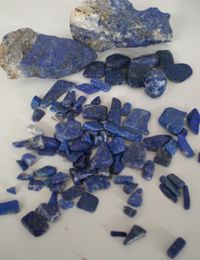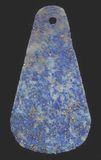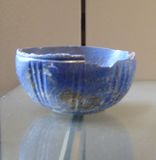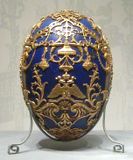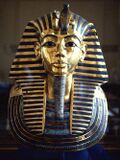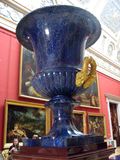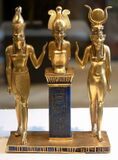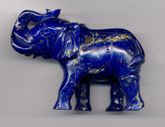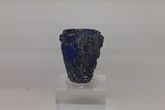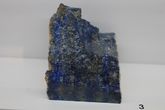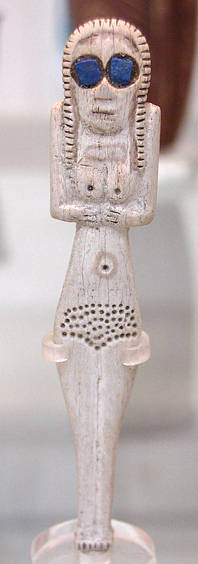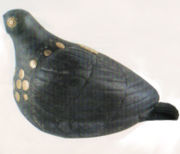لازورد
| لازورد Lapis lazuli | |
|---|---|
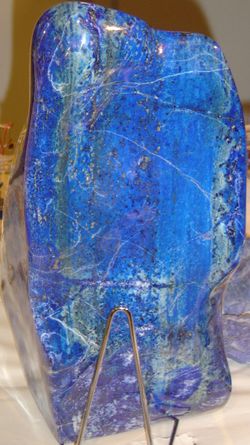 قطعة مصقولة من اللازورد | |
| العامة | |
| التصنيف | حجر |
| الصيغة (repeating unit) | خليط من المعادن |
| النظام البلوري | None, as lapis is a rock. Lazurite, the main constituent, frequently occurs as dodecahedra |
| التعرف | |
| Color | أزرق, mottled with white calcite and brassy pyrite |
| Crystal habit | Compact, massive |
| Cleavage | None |
| Fracture | Uneven-Conchoidal |
| Mohs scale hardness | 5 - 5.5 |
| Luster | dull |
| Streak | light blue |
| الجاذبية النوعية | 2.7 - 2.9 |
| Refractive index | 1.5 |
| سمات أخرى | The variations in composition cause a wide variation in the above values. |
لازَوَرد هو معدن سماوي الزرقة يستخدم كحجر كريم للزينة, تعتبر أجود أنواع اللازورد ما كانت زرقته صافية و ضاربة على الحمرة أو الخضرة. كلمة لازورد هي كلمة ذات أصول فارسية تمت إضافتها للغة العربية. ثم انتقلت الكلمة من العربية للاتينية (lazulum) و منها إلى بقية اللغات الأوروبية. يقدر تاريخ بداية استخراج حجر اللازرد إلى 6500 عام حيث كان يستخرج من بدخشان في أفغانستان. كما وجدت للحجر آثار في مواقع تعود لحقبة مصر ما قبل الأسر. كما يمكن إيجاد الحجر في القوقاز وموريتانيا.
. . . . . . . . . . . . . . . . . . . . . . . . . . . . . . . . . . . . . . . . . . . . . . . . . . . . . . . . . . . . . . . . . . . . . . . . . . . . . . . . . . . . . . . . . . . . . . . . . . . . . . . . . . . . . . . . . . . . . . . . . . . . . . . . . . . . . . . . . . . . . . . . . . . . . . . . . . . . . . . . . . . . . . . .
الوصف
مكوناته
يتكون حجر اللازورد من (25% إلى 40%) من معدن اللازورد إضافة إلى السيليكون و الأكسجين و الألومنيوم و الكبريت يرمز لحجر اللازورد بالصيغة (Na,Ca)8(AlSiO4)6(S,SO4,Cl)1-2.
التاريخ والفن
قلادة من اللازورد من بلاد الرافدين حوالي 2900 ق.م.
لقطة مقرّبة لترصيع اللازورد في القرن الخامس والعشرين ق.م. تمثال إبيه إيل، من ماري، سوريا.
تساريڤتش (بيض فابرجيه). يغطي النمط الذهبي المتكرر المفاصل، مما يجعل البيضة تبدو وكأنها منحوتة من كتلة واحدة من اللازورد.
في القناع الجنائزي للملك توت عنخ آمون (1341-1323 ق.م.)، اِستُخدِم اللازورد لحواجب الملك
Carved lapis lazuli mountain scene, from the Chinese Qing Dynasty (1644–1912)
Girl with a Pearl Earring (1665) by Johannes Vermeer is painted with ultramarine, a natural pigment made from lapis lazuli
في العالم القديم
Lapis lazuli has been mined in Afghanistan and exported to the Mediterranean world and South Asia since the Neolithic age.[1] Lapis lazuli beads have been found at Mehrgarh, a neolithic site near Quetta in Pakistan,[2] on the ancient trade route between Afghanistan and the Indus Valley, dating to the 7th millennium BC. Quantities of these beads have also been found at 4th millennium BC settlements in Northern Mesopotamia, and at the Bronze Age site of Shahr-e Sukhteh in southeast Iran (3rd millennium BC). A dagger with a lapis handle, a bowl inlaid with lapis, and amulets, beads, and inlays representing eyebrows and beards, were found in the Royal Tombs of the Sumerian city-state of Ur from the 3rd Millennium BC.[1]
Lapis was also used in ancient Mesopotamia by the Akkadians, Assyrians, and Babylonians for seals and jewelry. In the Mesopotamian poem the Epic of Gilgamesh (17th-18th Century BC), one of the oldest known works of literature, lapis lazuli is mentioned several times. The Statue of Ebih-Il, a 3rd millennium BC statue found in the ancient city-state of Mari in modern-day Syria, now in the Louvre, uses lapis lazuli inlays for the irises of the eyes.[3]
In ancient Egypt, lapis lazuli was a favorite stone for amulets and ornaments such as scarabs. Lapis jewelry has been found at excavations of the Predynastic Egyptian site Naqada (3300–3100 BC). At Karnak, the relief carvings of Thutmose III (1479-1429 BC) show fragments and barrel-shaped pieces of lapis lazuli being delivered to him as tribute. Powdered lapis was used as eyeshadow by Cleopatra.[4][5]
Jewellery made of lapis lazuli has also been found at Mycenae attesting to relations between the Myceneans and the developed civilizations of Egypt and the East.[6]
In late classical times and as late as the Middle Ages, lapis lazuli was often called sapphire (sapphirus in Latin, sappir in Hebrew),[7] though it had little to do with the stone today known as the blue corundum variety sapphire. In his book on stones, the Greek scientist Theophrastus described "the sapphirus, which is speckled with gold," a description which matches lapis lazuli.[8]
There are many references to sapphires in the Old Testament, but most scholars agree that, since sapphire was not known before the Roman Empire, they most likely are references to lapis lazuli. For instance, Exodus 24:10: "And they saw the God of Israel, and there was under his feet as it were a paved work of a sapphire stone.." (KJV). The term used in the Latin Vulgate Bible in this citation is "lapidus sapphiri," the term for lapis lazuli.[9] Modern translations of the Bible, such as the New Living Translation Second Edition,[10] refer to lapis lazuli in most instances instead of sapphire.
استعمل اللازورد في المجوهرات منذ العصور القديمة ويحتوي قبر الملك توت عنخ أمون الذي حكم مصر خلال القرن 14 ق.م. على عديد من الأشياء المصنوعة من الذهب واللازورد. وقد اعتقد القدماء بأنّ للازورد خصائص طبية، فكانوا يسحقون الحجر ويمزجونه بالحليب، وكان المزيج يستعمل طلاء للبثور والتقرّحات. وقد سُحِقَ اللاّزورد ذات يوم لإنتاج الصباغ اللازوردي وهو صبغ أزرق اسْتُعْمِلَ للرّسم.
طالع أيضاً
الهامش
- ^ أ ب Moorey, Peter Roger (1999). Ancient mesopotamian materials and industries: the archaeological evidence. Eisenbrauns. pp. 86–87. ISBN 978-1-57506-042-2.
- ^ Monthly, Jewellery (2015-04-02). "A complete guide to Gemstones". Jewellery & Watch Magazine | Jewellery news, jewellery fashion and trends, jewellery designer reviews, jewellery education, opinions | Wrist watch reviews - Jewellery Monthly (in الإنجليزية البريطانية). Retrieved 2017-08-28.
- ^ Claire, Iselin. "Ebih-Il, the Superintendent of Mari". Musée du Louvre. Retrieved 10 October 2012.
- ^ خطأ استشهاد: وسم
<ref>غير صحيح؛ لا نص تم توفيره للمراجع المسماةbc1995 - ^ [1] Moment of Science site, Indiana Public Media
- ^ Alcestis Papademetriou, Mycenae, John S. Latsis Public Benefit Foundation, 2015, p. 32.
- ^ Schumann, Walter (2006) [2002]. "Sapphire". Gemstones of the World. trans. Annette Englander & Daniel Shea (newly revised & expanded 3rd ed.). New York: Sterling. p. 102.
In antiquity and as late as the Middle Ages, the name sapphire was understood to mean what is today described as lapis lazuli.
- ^ Theophrastus, On Stones (De Lapidibus) - IV-23, translated by D.E. Eichholtz, Oxford University Press, 1965.
- ^ Pearlie Braswell-Tripp (2013), Real Diamonds and Precious Stones of the Bible (ISBN 978-1-4797-9644-1)
- ^ "In His Image Devotional Bible" (IBN 978-1-4143-3763-0)
المصادر
- Bowersox, Gary W.; Chamberlin, Bonita E. (1995), Gemstones of Afghanistan, Tucson, AZ: Geoscience Press.
- Oldershaw, Cally (2003), "Lapis Lazuli", Firefly Guide to Gems, Toronto: Firefly Books.
وصلات خارجية
- Lapis lazuli at Gemstone.org
- "The Use of Lapis Lazuli as a Pigment in Medieval Europe"
- Documentation from online course produced by University of California at Berkeley
- Lapis Lazuli from Afghanistan, Sar-e-Sang Mine, Jurm, Afghanistan
- All-round information about Lapis Lazuli, emphasis on the Chilean veriety

